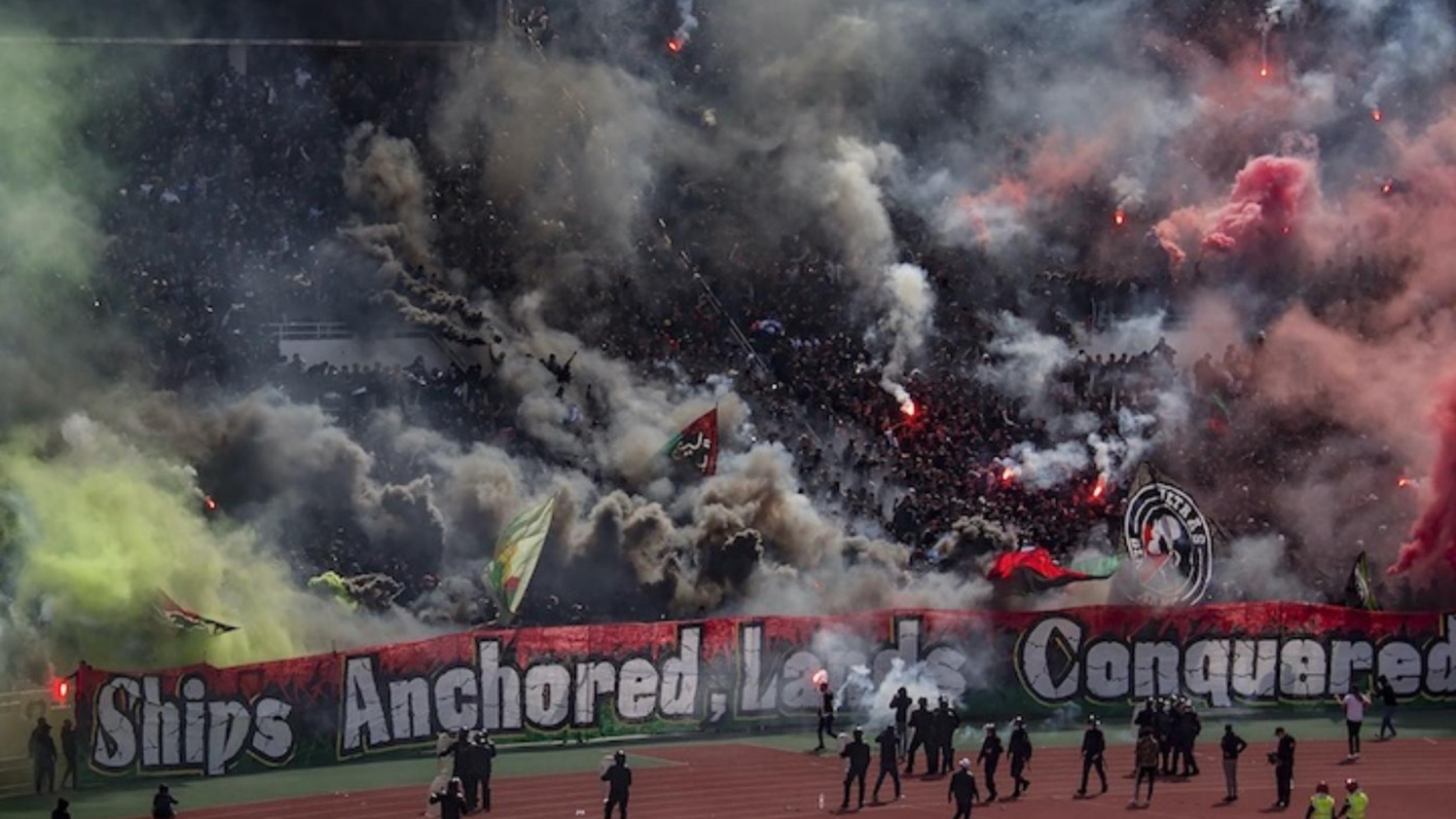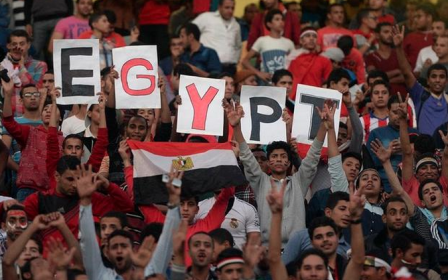Morocco’s football ultras blame 'failing' state for recent violence

After two years of matches being played behind closed doors, fans finally returned to Morocco's football stadiums at the end of February.
Although the decision was met with enthusiasm among the public, the Royal Moroccan Football Federation (FRMF) had its concerns.
The federation president last month urged clubs to avoid violence and maintain a good atmosphere as they returned to watch live games.
'Acts of violence are indications of the problems and scourges pervading our society. It’s society itself that produces and feeds this violence we observe'
- Abderrahim Bourkia, sociologist
“Fouzi Lekjaa has appealed to club chairmen and managers to play their part in bringing life back to the stadiums and promoting a civilised image of Moroccan football,” a Federation press release said on 25 February.
The federation’s fears, however, proved to be well-founded.
New MEE newsletter: Jerusalem Dispatch
Sign up to get the latest insights and analysis on Israel-Palestine, alongside Turkey Unpacked and other MEE newsletters
On 20 March, during a match at Agadir in Morocco’s south-west, between the home club Hassania d’Agadir and FUS Rabat, several brawls broke out and dozens of people were injured, including seven members of the security forces.
The police reaction was swift. Some 84 people were arrested after the match, including 50 minors, for public drunkenness, possession of knives and the destruction of public property, a local source told Middle East Eye. At least 42 of those detained remain in prison.
A week later, it was Rabat’s turn to witness violent scenes during a Moroccan Throne Cup match between the Maghreb Association Sportive (MAS) of Fez and the Sports Association of the Royal Moroccan Armed Forces (Asfar), the capital’s club, which lost 2-0.
Disappointed Asfar ultras hurled stones before invading the pitch, even targeting the police. The tally of the day’s events numbered 160 injured, including 85 policemen and 18 members of the auxiliary services, according to the General Directorate for National Security (DGSN).
Zero tolerance
“These acts of vandalism have caused material damage to several of the stadium facilities and buildings,” a DGSN press release noted.
“Investigations by the Rabat police department in the wake of these events led to the arrest of 160 individuals, including 90 minors, for their presumed involvement in football hooliganism, possession of knives, drunkenness, stone-throwing, and the destruction of public and private assets, as well as setting a vehicle on fire.”
Some 60 fans are still detained, including 17 minors.
On 14 March, the Federation decided to sanction both clubs, with a source within the organisation telling MEE: “We have zero tolerance for this type of behaviour. All parties will take responsibility for their actions.”
Asfar will play behind closed doors for the whole of the football season and MAS for the next two matches.
Translation: Harsh sanction for FAR! FRMF decrees the capital’s club must play out the season without fans. Do you agree?
The Rabat club ultras have been roundly blamed but they have pointed the finger at “criminals, unconnected to the group”.
“Everyone is accusing us of propagating this violence, without proof. We’re even being called a criminal organisation. These are the actions of criminals with no connection to us whatsoever,” said a member of the ultras group Black Army.
“This violence is the result of a failing education system and other societal issues. The ultras, in my experience, actually play an important role guiding youngsters, saving many of them from drugs and crime. Quite the opposite of what we’re being accused of,” he said.
'The ultras...actually play an important role guiding youngsters, saving many of them from drugs and crime. Quite the opposite of what we’re being accuse'
- Black Army member
Another member of the Black Army said that while some ultras were violent, they should not carry the full blame for the incident.
“How were these young people able to enter a football stadium armed with knives and clubs? A big match like that needs more policemen to ensure everyone’s safety,” he said.
Black Army also responded to the controversy, saying they have been scapegoated for societal problems, including a “defective” system of education.
“No way should we be blamed for the failings of those involved - we’re not responsible for managing our members. Our control, as a group, ends the moment the referee blows his whistle at the end of the match,” the ultras group wrote on 15 March on its Facebook page.
They added, distancing the group from events occurring after the end of the match: “We make our own contribution, for example by raising awareness of the rules to be followed after the match is over.
“We try as far as possible to control events but, sooner or later, the police need to rethink their response.”
Decades of violence
The phenomenon of football stadium violence is nothing new. In March 2016, at the end of a match at the Mohammed-V stadium between Raja Casablanca and Chabab Rif al-Hoceima, confrontations between two groups of Casablanca ultras ended with two dead and some 50 injured.
Three years later, the stadium hosting a match between Wydad (Casablanca) and Asfar was again the scene of stone-throwing at both players and the police. The situation was made all the more lamentable by the destruction of an ambulance. A number of supporters and members of the police sustained injuries.
There is no shortage of examples of the violence that besets football matches.
In his 2018 book, Ultras in the City, Moroccan sociologist Abderrahim Bourkia traces the history of this phenomenon some 30 years back to the Moulay Abdellah stadium in Rabat, the same field that hosted the game between Asfar and MAS on 13 March.
“The history of football stadium violence in Morocco started on a Spring afternoon in 1993, in Rabat,” said Bourkia, a researcher from the LAMES Mediterranean Laboratory of Sociology in Aix-Marseille.
“Raja, after having eliminated their arch-rivals Wydad, lost the quarter-final match in the prestigious Throne Cup against the Marrakech team Kawkab by three goals to one.”
In the wake of defeat, Bourkia said, some fans who “wanted to be seen” tore down through the stadium “ripping out seats in Rabat’s Moulay Abdellah stadium, thus writing the first page of the story of Moroccan football violence.”
“The unusual aspect of this first act of violence is that it was broadcast live on television. Since that day, the phenomenon of violence has gained visibility,” he added.
“The supporters of Raja were labelled ‘hooligans’. So, from this match onwards, violence was presented as an accepted and expected part of football fandom, even before the birth of the ultras movement.”
Hostility towards authority symbols
What does this behaviour mean? The ultras movement may exist in several countries but in Morocco it is defined by some specific traits.
“Often, fans see themselves as the polar opposites of the rival team’s supporters and the police, the government, the wealthy who exploit the poor and the country. They focus their hostility on all symbols of authority,” Bourkia writes in his book.
“Often, fans see themselves as the polar opposites of the rival team’s supporters and the police, the government, the wealthy who exploit the poor and the country.
With these confrontations between groups, he says: “It’s ‘us’ against ‘them’. Settling scores is common practice among football fans, the culmination of the antagonistic acculturation process.”
“For some football fans, joining an ultras group means using violence against other groups. It’s of very little consequence to them, despite attracting the loathing and condemnation of society.”
The sociologist also describes how this violence is “rooted in the national socioeconomic fabric”.
For Bourkia, “acts of violence are indications of the problems and scourges pervading our society. It’s society itself that produces and feeds this violence we observe.”
The stadium, he notes, "just brings in the fans”, which “seems to indicate the impossibility of disassociating economic injustice and outbreaks of violence”.
“All sociological reflection turns around frustration as a driver for violence. Economic discrimination may provide an explanation for acts of violence. The failure of a social group to achieve legitimate aims is a motive for aggression,” Bourkia says in his book.
Consequently, he warns against the stigmatisation of the stadium and the ultras without looking deeper into the issues behind such behaviour.
“Blaming them, rightly or wrongly, for acts of violence without admitting that certain acts correspond to the delinquency that we witness in everyday social life is tantamount to burying our head in the sand and turning a blind eye to the real causes,” he says.
This article is a translation of a story originally published on Middle East Eye's French website.
Middle East Eye delivers independent and unrivalled coverage and analysis of the Middle East, North Africa and beyond. To learn more about republishing this content and the associated fees, please fill out this form. More about MEE can be found here.





